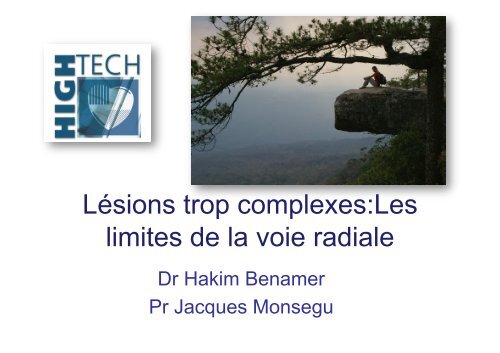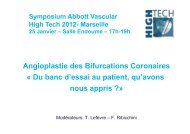Télécharger la présentation - Mediathèque du congrès de High ...
Télécharger la présentation - Mediathèque du congrès de High ...
Télécharger la présentation - Mediathèque du congrès de High ...
Create successful ePaper yourself
Turn your PDF publications into a flip-book with our unique Google optimized e-Paper software.
Lésions trop complexes:Les<br />
limites <strong>de</strong> <strong>la</strong> voie radiale<br />
Dr Hakim Benamer<br />
Pr Jacques Monsegu
Mr BUS. Agé <strong>de</strong> 75 ans<br />
SCA ST – avec troponine à 1.5 ng/ml<br />
FdR: Tabagisme ancien<br />
ATCD cardio: 0<br />
ECG: T
Coronarographie le 3/12/2010<br />
Atteinte Bitroncu<strong>la</strong>ire IVA 2 et Cx
Coronarographie 3 <strong>de</strong>c 2010<br />
Atteinte Bitroncu<strong>la</strong>ire IVA 2 et Cx
Heart Team<br />
Traitement médical seul<br />
Angiop<strong>la</strong>stie: IVA et Cx ?<br />
Chirurgie<br />
Revascu<strong>la</strong>risation FFR guidée<br />
Angiop<strong>la</strong>stie<br />
Stratégie<br />
Voie d’abord
Angiop<strong>la</strong>sties <strong>de</strong> l‘IVA 2 et Cx 6 <strong>de</strong>c 2010<br />
Voie radiale droite (EBU 3.5 6F)<br />
Ballon apex 2.0x12 mm
Angiop<strong>la</strong>sties <strong>de</strong> l‘IVA 2 et Cx<br />
Circonflexe: Prédi<strong>la</strong>tation au ballon 2.5x12mm puis stent nu 3x14 mm
Résultat sur l‘IVA que faire?<br />
Malgré anchoring ballon dans <strong>la</strong> diagonale<br />
pas possible <strong>de</strong> passer le stent dans l’IVA
Cath<strong>la</strong>b Team<br />
Traitement médical seul ?<br />
Angiop<strong>la</strong>stie re<strong>du</strong>x <strong>de</strong> l’IVA?<br />
Chirurgie combinée?<br />
Stratégie<br />
Voie d’abord
Angiop<strong>la</strong>stie <strong>de</strong> l‘IVA 7 <strong>de</strong>c 2010<br />
Abord radial droit 6F EBU 3.75
Rotab<strong>la</strong>tor fraise <strong>de</strong> 1.25mm<br />
Plusieurs passages à 190.000 t/m
Inf<strong>la</strong>tions très prolongées, neutralisation <strong>de</strong><br />
l‘héparine, stent nu 2.5x14 mm<br />
Stent nu 2.5x14 mm puis Ballon 3.0x15 mm<br />
Que faire ?
Drainage
Assurer l‘hémodynamique<br />
Intubation/ Drainage/Cell saver
Assurer l‘hémodynamique<br />
Intubation/ Dreinage/Cell saver
Jostent Graft master 3x12 et 3x16 mm<br />
Anchoring ballon 2.5x12 mm<br />
7 F Radiale AL1
Résultat
Aval DES 2.25x15 mm<br />
Amont bifurcation DES 3x18 mm
En fin <strong>de</strong> procé<strong>du</strong>re (extubé et retrait drain)
Pourquoi autant d‘obstination creased as successive punctures were pour performed and<strong>la</strong> this<br />
was <strong>du</strong>e to vessel narrowing or occlusion. Although it is<br />
voie radiale?<br />
1 - Tri<strong>du</strong>x <strong>de</strong> radiale est-ce vraiment raisonnable?<br />
2 - Appui moins Thrombose bon déjà un <strong>de</strong> échec <strong>la</strong> <strong>de</strong> radiale franchissement <strong>du</strong> stent<br />
3 – Rota et voie radiale<br />
4 - 7 French par voie radiale dans<br />
primo<br />
un contexte<br />
ponction<br />
<strong>de</strong> survie!<br />
re<strong>du</strong>x p<br />
Ø 2.63±0.35 2.53±0.39 < 0.05<br />
Fig. 1. Time course of radial arterial diameter changes. No<br />
significant change in mean internal radial arterial diameter was<br />
observed between preproce<strong>du</strong>re and 1 day after proce<strong>du</strong>re for<br />
either an initial proce<strong>du</strong>re or a repeat proce<strong>du</strong>re. The mean<br />
radial arterial diameter was 2.63 0.35 mm before the initial<br />
proce<strong>du</strong>re and 2.51 0.29 mm 4.5 months after the first proce<strong>du</strong>re<br />
1771 (P < patients<br />
0.05). No significant difference in radial arterial<br />
diameter changes was observed for patients receiving the di-<br />
dont 117 re<strong>du</strong>x<br />
agnostic proce<strong>du</strong>re or PTCA.<br />
TABLE III. Proce<strong>du</strong>ral Results and Complications<br />
Initial Repeated<br />
Success rate (%) 114 (97.4) 115 (98.3)<br />
Cross-over a<br />
3 (2.6) 2 (1.7)<br />
Puncture failure<br />
Vascu<strong>la</strong>r complications (%)<br />
0 (0) 0 (0)<br />
Perforations 0 (0) 0 (0)<br />
Occlusion b<br />
0 (0) 3 (2.6)<br />
Major bleeding 0 (0) 0 (0)<br />
a Cross-over to femoral artery.<br />
b P 0.05.<br />
cases at 4 weeks, one case at 2 weeks); two cases had<br />
high SAR (0.91 and 0.93) and one case had small radial<br />
artery diameter (1.82 mm). Late recanalization of the<br />
occlu<strong>de</strong>d radial artery <strong>du</strong>ring the 12 weeks after proce<strong>du</strong>re<br />
was not observed in three cases (Table III).<br />
at the time of repeated use, <strong>du</strong>e maybe to the physician<br />
being skillful with radial artery puncture technique and<br />
catheter manipu<strong>la</strong>tion. Sakai et al. [10] have reported that<br />
the dropout rates for transradial approach (TRA) in-<br />
difficult to exp<strong>la</strong>in the mechanism of the vessel narrowing<br />
in our study, we <strong>de</strong>monstrated significant vessel<br />
narrowing after the transradial proce<strong>du</strong>re <strong>du</strong>ring longterm<br />
follow-up.<br />
Consi<strong>de</strong>ring recent increased concern of the radial<br />
artery as a grafting artery in coronary artery bypass<br />
grafts, radial artery occlusion or functional loss might be<br />
important problem in patients with transradial coronary<br />
proce<strong>du</strong>res [14,15]. In our study, the frequency of radial<br />
artery occlusion was 0% and 2.6% after the initial and<br />
repeated proce<strong>du</strong>re, respectively. Although it is difficult<br />
to find the factor of radial arterial occlusion <strong>du</strong>e to low<br />
Ratio 0.68 ± 0.12 0.70 ± 0.12 ns<br />
inci<strong>de</strong>nce of radial artery occlusion, we could hypothe-<br />
size that the bigger size of arterial sheath might incite<br />
more injury to the arterial puncture site. In the repeated<br />
proce<strong>du</strong>re, more PTCA was performed compared to the<br />
initial proce<strong>du</strong>re (P 0.04). This re<strong>la</strong>tion might be<br />
inferred from the other findings; the radial arterial occlusion<br />
was very low (0.8%) in transradial coronary angiography<br />
with a 4 Fr catheter (0.8%) [5] and 2.8% for<br />
transradial coronary artery angiop<strong>la</strong>sty using at least 6 Fr<br />
catheter in our data. The inci<strong>de</strong>nce of radial artery occlusion<br />
among 1,771 transradial coronary proce<strong>du</strong>res<br />
<strong>du</strong>ring the same study period was 11 patients (0.6%).<br />
Therefore, radial artery occlusion was higher in repeate<strong>du</strong>se<br />
patients than in total first-use patients (2.6% vs.<br />
0.7%; P 0.01). Radial artery occlusion is simi<strong>la</strong>r to<br />
Nagai et al. [13] (2%), but less than Saito et al. [16]<br />
(6.8%). Saito et al. [16] inclu<strong>de</strong>d cases with high proportion<br />
of SAR higher than 1.1, in contrast to SAR of less<br />
Yoo Cathet Cardiovasc Intervent 2003; 58: 301-4
Pourquoi autant d‘obstination pour <strong>la</strong><br />
voie radiale?<br />
1 - Tri<strong>du</strong>x <strong>de</strong> radiale est-ce vraiment raisonnable?<br />
2 - Appui moins bon déjà un échec <strong>de</strong> franchissement <strong>du</strong> stent<br />
3 - Rota et voie radiale<br />
4 - 7 French par voie radiale dans un contexte <strong>de</strong> survie!
Backup Force of Guiding Catheters for the Right Coronary<br />
Artery in Transfemoral and Transradial Interventions<br />
Ikari Y, J invasive Cardiol 2009;21:570–574
Backup Force of Guiding Catheters for the Right Coronary<br />
Artery in Transfemoral and Transradial Interventions<br />
Ikari Y, J invasive Cardiol 2009;21:570–574
Backup Force of Guiding Catheters for the Right Coronary<br />
Artery in Transfemoral and Transradial Interventions<br />
Ikari Y, J invasive Cardiol 2009;21:570–574
(guiding) Anchoring techniques<br />
Anchoring wire<br />
Anchoring balloon<br />
Anchoring stent<br />
Mother and child<br />
Tornus …
Pourquoi autant d‘obstination pour <strong>la</strong><br />
voie radiale?<br />
1 - Tri<strong>du</strong>x <strong>de</strong> radiale est-ce vraiment raisonnable<br />
2 - Appui moins bon déjà un échec <strong>de</strong> franchissement <strong>du</strong> stent<br />
3 - Rota et voie radiale<br />
4 - 7 French par voie radiale dans un contexte <strong>de</strong> survie!
1000<br />
0<br />
NCN : EVOLUTION DE L’ACTIVITE 2002-2006<br />
16<br />
1003<br />
1.6%<br />
26<br />
1043<br />
2.5%<br />
36<br />
1176<br />
3%<br />
ROTA 2002 ROTA 2003 ROTA 2004 ROTA 2005 ROTA 2006<br />
56<br />
4%<br />
1384<br />
62<br />
1375<br />
4,5%<br />
Ph Brunel RadialAlpes 2009
%<br />
2005, Between July and <strong>de</strong>cember<br />
29 french centers, All consecutive rotab<strong>la</strong>tor proce<strong>du</strong>res<br />
252 patients, 2.13% (0,3-6%) of all proce<strong>du</strong>res<br />
100<br />
80<br />
60<br />
40<br />
20<br />
0<br />
REGISTRE TAROT : FRANCE 6 mois<br />
22<br />
78<br />
RADIALE FEMORALE<br />
Ph Brunel RadialAlpes 2009
%<br />
10<br />
9<br />
8<br />
7<br />
6<br />
5<br />
4<br />
3<br />
2<br />
1<br />
0<br />
0,79<br />
5,95<br />
TAROT : COMPLICATIONS<br />
1,98<br />
(n=252)<br />
1,19 0,39 0,39<br />
Perforation dissection spasm slow flow burr stall gui<strong>de</strong> wire<br />
rupture<br />
Ph Brunel RadialAlpes 2009
Pourquoi autant d‘obstination pour <strong>la</strong><br />
voie radiale?<br />
1 - Tri<strong>du</strong>x <strong>de</strong> radiale est-ce vraiment raisonnable<br />
2 - Appui moins bon déjà un échec <strong>de</strong> franchissement <strong>du</strong> stent<br />
3 - Taille <strong>de</strong> <strong>la</strong> fraise<br />
4 - 7 French par voie radiale dans un contexte <strong>de</strong> survie!
Pourquoi autant d‘obstination pour <strong>la</strong><br />
voie radiale?<br />
1 - Tri<strong>du</strong>x <strong>de</strong> radiale est-ce vraiment raisonnable<br />
2 - Appui moins bon déjà un échec <strong>de</strong> franchissement <strong>du</strong> stent<br />
3 - Taille <strong>de</strong> <strong>la</strong> fraise<br />
4 - 7 French par voie radiale dans un contexte <strong>de</strong> survie!<br />
Yoo CCVI 2003 ; 58:301-304
O.D.<br />
2.00mm<br />
O.D.<br />
O.D. 2.29mm<br />
2.29mm<br />
O.D.<br />
2.16mm<br />
O.D.<br />
O.D. 2.49mm<br />
2.49mm<br />
O.D.<br />
2.29mm<br />
O.D.<br />
2.62mm<br />
O.D.<br />
2.62mm
Pourquoi autant d‘obstination pour <strong>la</strong><br />
voie radiale?<br />
1 - Tri<strong>du</strong>x <strong>de</strong> radiale est-ce vraiment raisonnable<br />
2 - Appui moins bon déjà un échec <strong>de</strong> franchissement <strong>du</strong> stent<br />
3 - Taille <strong>de</strong> <strong>la</strong> fraise<br />
4 - 7 French par voie radiale dans un contexte <strong>de</strong> survie!
Pourquoi autant d‘obstination pour <strong>la</strong><br />
voie radiale?<br />
1 - Tri<strong>du</strong>x <strong>de</strong> radiale est-ce vraiment raisonnable<br />
2 - Appui moins bon déjà un échec <strong>de</strong> franchissement <strong>du</strong> stent<br />
3 - Taille <strong>de</strong> <strong>la</strong> fraise<br />
4 - 7 French par voie radiale dans un contexte <strong>de</strong> survie!
Pourquoi autant d‘obstination pour <strong>la</strong><br />
voie radiale?<br />
1 - Tri<strong>du</strong>x <strong>de</strong> radiale est-ce vraiment raisonnable<br />
2 - Appui moins bon déjà un échec <strong>de</strong> franchissement <strong>du</strong> stent<br />
3 - Taille <strong>de</strong> <strong>la</strong> fraise<br />
4 - 7 French par voie radiale dans un contexte <strong>de</strong> survie!
CONCLUSIONS<br />
Toujours <strong>la</strong> Radiale<br />
Connaitre les atouts et <strong>de</strong>s faiblesses<br />
<strong>de</strong> <strong>la</strong> voie d’abord radiale pour arbitrer les choix<br />
techniques<br />
Faiblesses<br />
- Tailles variables<br />
- Variations anatomiques<br />
- Problèmes <strong>de</strong> support (Dte > Gche)






